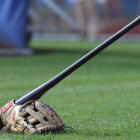Part of being a baseball fan these days is having at least a passing familiarity with advanced statistics -- i.e., the metrics that go beyond the usual fare of RBI, batting average, ERA, fielding percentage and the like.
In case you lack that passing familiarity or you're merely in need of a refresher course on a particular measure, we've put together the following glossary of advanced baseball statistics. It's certainly not an exhaustive rundown, but it does include all of the non-traditional stats you'll encounter most of the time (including within these very pages).
Batting Average on Balls in Play (BABIP)
Balls in play are fair-hit balls that don't leave the park, and BABIP is the batting average solely on those balls that are in play and theoretically able to be fielded. Typically, a pitcher's BABIP will settle in at around .290 or so. While some pitchers have some ability to control BABIP to a limited extent, generally at the MLB level when you see a pitcher's BABIP widely diverge from that .290-.300 range, luck -- good or bad -- is likely playing a role (in addition to the quality of the defense behind him). It's one of the first things we look at when we're trying to determine whether a pitcher's performance is sustainable.
As for hitters, BABIP is little more "sticky" and reflective of true skill, but wide swings that are out of step with a hitter's established ability and or league norms can indicate the same presence of good or bad luck.
Defensive Efficiency Rating (DER)
DER is the percentage of balls in play (i.e., fair batted balls that don't go over the fence) that a team defense converts into outs. That, after all, is the whole point of defense at the team level. Unlike the deeply flawed fielding percentage, DER accounts for range and the team-wide ability to make the routine play. In 2018, the Oakland Athletics led MLB with a DER of .717, which means they converted 71.7 percent of balls in play into outs.
Defensive Runs Saved (DRS)
DRS is the defensive component of bWAR. It measures the number of runs saved above the MLB average at a given player's position and includes a "degree of difficulty" element. For instance, the less likely a play is to be made by the average fielder, the more credit a player gets for pulling it off. It's built off the Fielding Bible's plus-minus system, which you can read more about here. Per Fielding Bible, here's what goes into calculating DRS, which measures all phases of defense:
- Plus/Minus Runs Saved (All Non-Catchers)
- Catcher Adjusted Earned Runs Saved (Catchers)
- Catcher Stolen Base Runs Saved (Catchers)
- Pitcher Stolen Base Runs Saved (Pitchers)
- Outfielder Arm Runs Saved (Outfielders)
- Bunt Runs Saved (Corner Infielders, Catchers, Pitchers)
- Double Play Runs Saved (Middle Infielders and Corner Infielders)
- Good Plays/Misplays Runs Saved (All Fielders)
There's no such thing as a perfect defensive metric, but the advanced ones are far, far better than fielding percentage, which doesn't account for a fielder's range.
ERA+
This is a pitcher's ERA adjusted to reflect home ballpark and league environment. It's scaled so that a mark of 100 is league average, and the higher the mark the better from the pitcher's standpoint. An ERA+ of 110 means that the pitcher's park- and league-adjusted ERA was 10 percent better than the league mean. Likewise, an ERA+ of 90 means that the pitcher's park- and league-adjusted ERA was 10 percent worse than the league mean. In 2018, Blake Snell of the Rays led the majors with an ERA+ of 219. That means his ERA of 1.89 was an astounding 119 percent better than the league average once you adjust for the league offensive environment and the tendencies of Tropicana Field.
Fielding-Independent Pitching (FIP)
FIP is scaled to look like ERA, but it's different in that it reflects just those outcomes that have nothing to do with fielding -- i.e., strikeouts, walks, and home runs allowed. As such, it can better measure of raw pitching skill than ERA is. In 2018, Jacob deGrom led MLB with an ERA of 1.70 and an FIP of 1.98. So while he may have been a little lucky to have that ERA, he was almost just as dominant at the FIP level.
Game Score
Game Score is a quick-and-dirty Bill James metric that measures a pitcher's dominance or lack thereof in a given start. A Game Score of 50 is average, 90 and above is a gem, and anything of 20 or worse is a likely a disaster start. Here's how it's calculated ...
- Start with 50 points.
- Add one point for each out recorded.
- Add two points for each inning completed after the fourth.
- Add one point for each strikeout.
- Subtract two points for each hit allowed.
- Subtract four points for each run allowed, earned or unearned.
- Subtract one point for each walk.
In Kerry Wood's legendary 20-strikeout performance against the Astros in 1998, he authored a Game Score of 105 -- one of the highest marks ever.
Isolated Power (ISO)
ISO -- also sometimes referred to as "Isolated Slugging" -- is an indicator of a hitter's raw power. It's simply batting average subtracted from slugging percentage. Basically, it's how many extra bases a hitter averages per at-bat. An ISO of less than .100 indicates a hitter with very little power, while an ISO of .250 or more marks a true slugger.
On-Base Plus Slugging (OPS)
OPS is on-base percentage added to his slugging percentage. The resulting figure gives a nice snapshot of production on a rate basis (i.e., not reflective of playing time). For pitchers, you'll occasionally see "OPS allowed," but it's usually used for hitters. It's not perfect, in that on-base percentage is the more valuable component, but the OPS formula treats OBP and SLG as equals. It's good shorthand, though. Any OPS of 1.000 or more signifies an elite hitter, in the presence of adequate playing. In 2018, the league average OPS was .728.
OPS+
OPS+ is OPS (on-base percentage plus slugging percentage -- see above) adjusted to reflect league and ballpark conditions. Just like ERA+ (see above), OPS+ is scaled so that 100 is the league average. Similarly, an OPS+ of 110 means that the hitter's park- and league-adjusted OPS was 10 percent better than the league mean. An OPS+ of 90 means that the hitter's park- and league-adjusted OPS was 10 percent worse than the league mean. Mike Trout in 2018 lead the majors with an OPS+ of 199. That means his park- and league-adjusted OPS was 99 percent better than the league standard.
Strikeout Percentage (K%) and Walk Percentage (BB%)
This is a pitcher's (or a hitter's) strikeouts and walks expressed as a percentage of total batters faced/total plate appearances. K% and BB% constitute an improvement over the more familiar K/9 and BB/9 in that the former aren't tied to innings and thus account for how many batters a pitcher faces (i.e., a pitcher who strikes out all three batter he faces in an inning is doing better than one who "strikes out the side" while allowing three runs in a frame, and K/9 doesn't account for such things). In 2018, the average pitcher struck out 22.3 percent of opposing hitters while walking 8.5 percent of same.
Ultimate Zone Rating (UZR)
This is the defensive statistic used in FanGraphs' version of Wins Above Replacement (see below) for players other than catchers. UZR divides the field up into defensive zones and also corrects for the speed of a batted ball. It's denominated in runs and compares fielders to the MLB average at their respective positions. A full discussion of UZR is beyond the scope of this exercise, so here's this lengthy explanation by UZR's creator, Mitchel Lichtman.
To repeat from above: There's no such thing as a perfect defensive metric, but the advanced ones are far, far better than fielding percentage, which doesn't account for a fielder's range.
Weighted On-Base Average (wOBA)
wOBA assigns proper value to every possible offensive event that happens while a batter is at the plate. Those proper valuations of singles, doubles, homers, walks, etc., distinguish wOBA from more traditional measures like AVG, OBP, and SLG. Also, for simplicity wOBA is scaled to look like OBP, which means that, say, .400 is elite and .290 is pretty poor. Babe Ruth is the all-time leader with a patently absurd wOBA of .513. You can read more about wOBA at FanGraphs.
Weighted On-Base Average, Expected (xwOBA)
xwOBA grows out of wOBA (see immediately above) and is an estimation of what a hitter's wOBA should be based on things like exit velocity off the bat and launch angle. xwOBA attempts to strip away luck -- bad or good -- and defensive play from wOBA and identify a hitter's baseline skill. It's somewhat useful for getting an idea of how a hitter figures to perform in the near-term future. Basically, if a hitter's xwOBA is significantly lower than his wOBA, he's probably going to come back to earth at some point. There's some evidence that slower players tend to underperform relative to their xwOBA and faster players tend to overperform, but even so xwOBA has utility. On the other side of things, if a hitter's xwOBA is quite a bit higher than his wOBA, then better days are likely ahead. Here's more on xwOBA.
Weighted Runs Created+ (wRC+)
This one measures all phases of production at the plate and adjusts them for ballpark and league environments. The higher the wRC+, the better the hitter was. wRC+ is scaled so that a mark of 100 reflects a league-average hitter. wRC+ is like OPS+ (see above) in that regard, but it's an improvement over OPS+ because it takes into account baserunning, double plays, and so forth.
Wins Above Replacement (WAR)
WAR is an all-encompassing stat that attempts to measure a position player's or pitcher's total value. For position players, this means hitting, base-running and fielding are taken into account.
WAR is measured in theoretical runs and tied to a "replacement level" baseline. A replacement-level player is any player type who's cheaply and widely available to major-league teams in a pinch. Examples include some bench players, waiver claims, or minor-league veterans -- i.e., the kind of stop-gap a team can scare up in an emergency situation. By definition, these players are not good; they are in a real sense the least an MLB team can do when it comes to filling a role on the fly.
FanGraphs and Baseball-Reference are the two primary purveyors of WAR data, and there are some differences between the two calculations, especially when it comes to pitching. FanGraphs' version of WAR (usually abbreviated as "fWAR') uses as its primary inputs the elements of the game over which the pitcher (and catcher, to an extent) exerts the most control. To wit, fWAR pays the most heed to strikeouts, walks, home runs allowed, groundball-flyball tendencies, and infield popup rates. In contrast, bWAR is, generally speaking, driven by a pitcher's runs allowed, with adjustments made for the quality of the defense behind him. In other words, bWAR, relative to fWAR, makes less of an attempt to isolate pitching from fielding. As a consequence, you see the two methods diverge pretty substantially when it comes to some pitchers.
In a way, though, this seeming disconnect is a feature rather than a bug. Determining pitcher value is a tricky thing, and together these two distinct measures do a good job of capturing and rendering the many-splendored thing that is pitching. Want a "bottom line" measure of value that bakes in defense and blind luck into the mix, maybe for the purposes of helping you determine who deserves the Cy Young? Then bWAR is the right choice. Want something that isolates a pitcher's core skills and says something about his future outlook? Then fWAR is here to help. Some analysts even use a blend of the two measures to arrive at a WAR figure that provides a bit of both approaches. Those who complain, somewhat simplistically, that WAR is to be ignored because not even its advocates can agree on how to calculate it are really wishing that pitching itself weren't quite so complicated and nuanced.
To be sure, though, WAR does have weaknesses, especially when it comes to position players. Specifically, the defensive components of WAR -- Ultimate Zone Rating (UZR) for fWAR (more on UZR below) and Defensive Runs Saved (DRS) for bWAR -- aren't as definitive as we would like. Each is among the very best methods we have for assessing defensive value, but they're far from perfect.
If a player's WAR seems to be heavily uplifted or dragged down by an outlying single season of defensive data, then skepticism toward our ability to peg his value is warranted, especially if those defensive results don't match the player's reputation and prior history. Also, WAR isn't precise in the extreme. A player with a 3.3 WAR isn't irrefutably better than a player with, say, a 2.9 WAR. The error bars are there, but as blunt instruments go it's our best implement when it comes to gauging a player's overall value. In large part, that's because WAR does a tremendous job at reflecting offensive value and the duality of pitching.
WAR adds to our understanding of the game. Those who cite it as inerrant gospel are misguided -- almost as misguided as those who indulge in wholesale dismissals of WAR.
By definition, a players with a WAR of 0.0 is replacement-level. A WAR of roughly 2.0 is league-average, and a WAR of, say, 8.0 or higher is getting into MVP territory. Negative WARs are not only possible but common. When analysts say a player was "worth [x] wins," they're talking about his WAR and not, say, the number of pitching wins or game-winning RBI he racked up.
Win Probability Added (WPA)
How much a did a player alter a given game with his performance? This, broadly speaking, is the question that WPA attempts to answer. Basically, WPA tracks a team's percentage of winning a given game -- known as "win expectancy" -- and measures how a given player affects that percentage. RBI double in the early innings of an eventual 12-3 win? The hitter's WPA will go up, but not by all that much. Down 3-2 in the ninth, bases loaded with two outs and the batter strikes out? His WPA for the game is going to take a pretty substantial hit, since that was the quintessence of a clutch situation.
For season-long totals, a player's or pitcher's WPA tallies from each game are added up -- the positive and the negative -- to arrive at a final figure. You'll find that these generally track with our notions of who the best producers are. After all, good players tend to be good in all situations, and "clutch" best describes performances rather than the performers themselves.
We encourage you to check back from time to time, as we'll be adding to this glossary as more and more advanced statistics become commonly used by baseball fans and analysts.






















